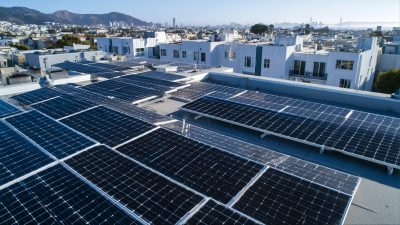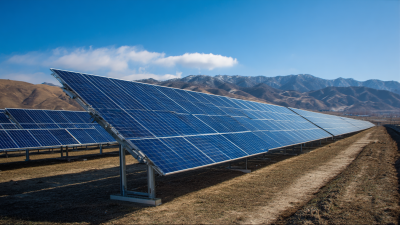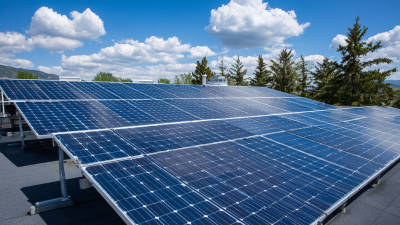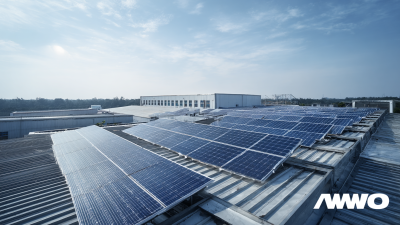As homeowners increasingly seek sustainable solutions to meet their energy needs, the appeal of solar power for home use has surged. According to the Solar Energy Industries Association, the residential solar market experienced an astounding 23% growth in 2020, showcasing a rising trend among homeowners to invest in renewable energy sources. This shift not only contributes to a reduction in greenhouse gas emissions, but it also offers financial benefits through lower utility bills and potential tax incentives. Furthermore, a report by the National Renewable Energy Laboratory indicates that residential solar installations can significantly increase property values, providing homeowners with a solid return on investment. As awareness of the advantages of solar power for home usage continues to grow, this blog aims to explore the myriad benefits it offers to homeowners, paving the way for a more sustainable and cost-effective future.

 Solar power has emerged as a transformative energy solution for homeowners, and understanding how it works is essential for those considering making the transition. At its core, solar power utilizes photovoltaic cells, which convert sunlight into electricity. When sunlight hits these cells, it excites electrons, creating a flow of electricity that can be used to power homes or be fed back into the grid. This process not only reduces reliance on traditional energy sources but also contributes to a cleaner environment by decreasing greenhouse gas emissions.
Solar power has emerged as a transformative energy solution for homeowners, and understanding how it works is essential for those considering making the transition. At its core, solar power utilizes photovoltaic cells, which convert sunlight into electricity. When sunlight hits these cells, it excites electrons, creating a flow of electricity that can be used to power homes or be fed back into the grid. This process not only reduces reliance on traditional energy sources but also contributes to a cleaner environment by decreasing greenhouse gas emissions.
For homeowners, the benefits of solar power extend beyond environmental impact; financial savings are a key advantage. By installing solar panels, homeowners can generate their own electricity, resulting in lower utility bills. Many regions also offer incentives such as tax credits and rebates for solar energy installations, making it a more affordable option. Additionally, solar power systems increase property values, providing a long-term investment that continues to pay dividends as energy costs fluctuate. Understanding the mechanics of solar power equips homeowners with the knowledge to make informed decisions about their energy consumption and financial investments.
Solar energy has become an increasingly attractive option for homeowners looking to reduce their energy bills and contribute to a more sustainable future. One of the most compelling benefits of solar power is the significant cost savings it offers. By harnessing the sun’s energy, homeowners can drastically lower their electricity expenses. Many individuals report saving hundreds of dollars annually, especially as utility rates continue to rise. With various incentive programs and tax credits available, the initial investment in solar panels can lead to long-term financial benefits.
Beyond cost savings, solar energy enhances property value. Homes equipped with solar panels are often more appealing to buyers, as they promise reduced energy costs and a lower carbon footprint. Additionally, as the world moves toward greener energy solutions, properties with solar installations are likely to stand out in the real estate market. Furthermore, homeowners gain energy independence, freeing themselves from fluctuations in energy prices and grid reliability. This autonomy, coupled with the environmental advantages, illustrates why adopting solar energy is a smart choice for modern homeowners.
| Benefit | Description | Estimated Savings ($/Year) | Environmental Impact |
|---|---|---|---|
| Cost Savings | Reduces electricity bills significantly by generating your own energy. | $1,000 - $2,500 | Lower carbon footprint |
| Tax Incentives | Homeowners can benefit from federal and state tax credits for installing solar panels. | Varies (up to 30% of installation cost) | Encourages renewable energy use |
| Increased Home Value | Homes with solar energy systems can have higher property values. | $10,000 - $30,000 | Promotes sustainable living |
| Energy Independence | Less reliance on the grid, protecting against energy price fluctuations. | N/A | Reduces reliance on fossil fuels |
| Low Maintenance Costs | Solar panels typically require minimal maintenance. | $200 - $400 | Encourages long-term sustainability |
When exploring solar power options, homeowners encounter a variety of solar panel types, each with unique benefits tailored to different needs. The primary types include monocrystalline, polycrystalline, and thin-film solar panels. According to the National Renewable Energy Laboratory (NREL), monocrystalline panels are known for their high efficiency, typically exceeding 20%, making them an excellent choice for homeowners with limited roof space. Their sleek design and longevity also ensure a robust return on investment over time.
Polycrystalline panels, on the other hand, are generally more affordable and slightly less efficient, with efficiency ratings averaging between 15-18%. This type is ideal for larger spaces where budget considerations are more pressing than maximizing efficiency. A report from Wood Mackenzie Power & Renewables indicates that the adoption of polycrystalline panels has surged, reflecting their popularity among budget-conscious homeowners. Lastly, thin-film solar panels are the least efficient but are lightweight and flexible, making them suitable for unconventional installations. Each type of solar panel offers distinct advantages that could significantly impact energy savings and the overall solar investment for homeowners.
This chart illustrates the estimated energy savings for homeowners based on different types of solar panels. The data represents the average annual savings associated with three popular types of solar panels over a 25-year period.
The installation of solar power systems has become increasingly vital for homeowners looking to reduce energy costs and enhance their property's value. The initial step in this process involves a comprehensive site assessment, where experts evaluate factors like roof orientation and shading. Homeowners should expect the installation process to cover several stages, often ranging from 1 to 3 days based on system size. According to recent reports, installing solar panels can cost approximately $28,000. However, many homeowners benefit from incentives that can substantially lower this figure.
As the installation progresses, homeowners should be prepared for inspections and testing to ensure the system’s functionality and compliance with local regulations. With the expiration of certain tax credits on the horizon, industry experts advise that those keen on solar power act swiftly. Neglecting to do so may result in missed financial benefits. Moreover, emerging energy-saving initiatives are designed to further assist homeowners in navigating this complex process, making solar adoption not just a sustainable choice but also a financially savvy one.
As homeowners consider the transition to solar power, understanding financing options and incentives is crucial. Many states and local governments offer tax credits and rebates that can significantly reduce the initial investment. For instance, the federal solar tax credit allows homeowners to deduct a percentage of their solar installation costs from their federal taxes, making solar more affordable. Researching local incentives can uncover additional savings, such as performance-based incentives which reward homeowners for the energy their systems produce over time.
When exploring financing options, homeowners can choose between solar loans, leasing, or power purchase agreements (PPAs). Solar loans give you ownership of the system and its associated tax benefits, while leasing or PPAs often require little to no upfront cost, enabling homeowners to benefit from solar energy without the burden of a large initial payment. It's essential to evaluate the long-term savings and the financial implications of each option before making a decision.
**Tip 1:** Always compare multiple financing options to find the best deal. Each lender may offer different rates and terms, so it's worth taking the time to shop around.
**Tip 2:** Don’t overlook community solar programs, which can provide a solar solution even if your home isn’t suited for panels. These programs allow you to buy into shared solar projects, getting benefits without the need for individual installations.







As electricity costs continue rising, many small households in Maharashtra seek sustainabl...Read More
Uttar Pradesh is making significant progress in adopting renewable energy, particularly so...Read More
With the Indian government actively promoting renewable energy through subsidies and polic...Read More
Tired of watching your electricity bills climb month after month and strain your pockets? ...Read More
Switching to solar energy in Gujarat has never been more profitable! With plenty of sunlig...Read More
If you live in Madhya Pradesh and want to save money on power while living a greener lifes...Read More
If you’re a resident of Bangalore looking to save on your skyrocketing electricity b...Read More
If you live in Karnataka and have been looking for an environmentally friendly, cost-effec...Read More
Delhi is a city that thrives on its vibrant energy, and what better way to complement that...Read More
As electricity costs continue rising, many small households in Maharashtra seek ...Read More
Uttar Pradesh is making significant progress in adopting renewable energy, parti...Read More
With the Indian government actively promoting renewable energy through subsidies...Read More